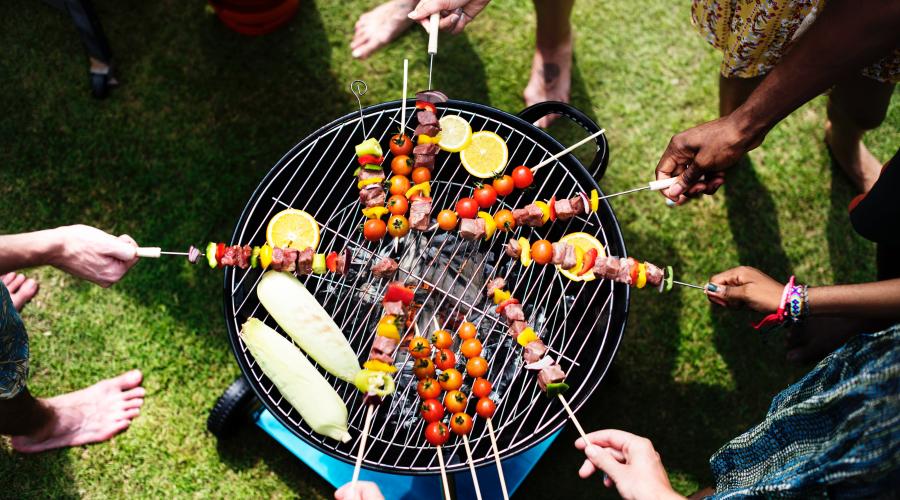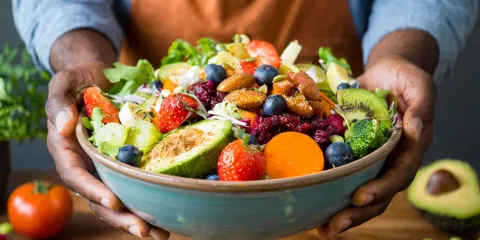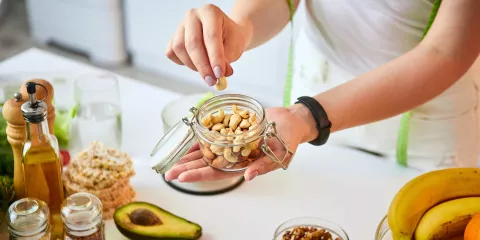
With delicious summer produce in season and longer days to enjoy outside, now’s the perfect time to grill, have a barbecue, or just cook a refreshing summer meal for your friends and family.
Even if you’re an amateur cook, you can easily accomplish this month’s bucket list item. Here’s how you can take your next step towards a heart-healthy lifestyle by grilling for your group.
Why should I cook for a crowd?
Not only is grilling a crowd-pleaser that makes it easy to feed all kinds of appetites (vegetarian, gluten-free, etc.), but it can also make an evening meal feel special. A lot of thought and intention goes into cooking for others, something we don’t always put into our everyday food choices. By slowing down and carefully considering our ingredients and the food we cook, we can form better relationships and habits with food.
And with great company, the great outdoors, and the easy cleanup that comes with cooking outside, you’ll be less tempted to eat out and more likely to make eating at home a habit.
Cook with color
When you’re deciding what you want to grill for your guests, consider adding as much color as possible to the spread. You want to “eat the rainbow” to soak up all the vitamins and nutrients that different fruits and vegetables have to offer.
One way you can integrate color into your bucket list meal is by making something like kebabs and using different colors of peppers and onions.
Go light on the carbs
Not only is bread filling, but it isn’t very nutritious. One simple way to make your cookout healthier is to avoid serving many carbs. Guests will most likely eat more than one hotdog, and those buns aren’t exactly packed with nutrients. Same goes for burgers. Consider wrapping burgers in lettuce wraps instead of buns or making for kebabs instead of hot dogs. And when dessert rolls around, set out a fruit tray instead of a tray of cookies.
Opt for lighter, leaner meats
Studies have shown that red meat, specifically processed red meat, is associated with an increased risk of cardiovascular disease, cancer, and even death [1]. You can make your meal a heart-healthy affair by grilling lighter, leaner meats like chicken and turkey.
Making burgers? Opt for ground turkey instead of beef to lower the fat content. And instead of grilling pork chops or sausages, consider making a chicken dish like this Paprika Herb-Rubbed Chicken or Grilled Chicken Taco Salad. If you’ve got your heart set on serving steaks, then try to choose lean cuts. This means those with the lowest fat percentage or the least marbling.
Consider going meatless
You can even go meatless by making your own veggie burgers or throwing some vegetarian “hot dogs” and “sausages” on the grill. You won’t even miss the meat with our recipe for lentil burgers.
But if you don’t want to go totally meatless, we recommend trying to make your meal’s sides vegetarian instead. Leave the fatty pork out of the baked beans and don’t put bacon in the side salad. Not only can this help you create a more balanced meal, but also keep any vegetarians at the table happy.
Make healthy substitutes
Speaking of sides, another way you can make your meal more heart healthy is to swap traditional barbecue sides for heart-healthy alternatives. Swap the famously fatty and high-cholesterol potato salad side for a lighter, healthier option, like this Creamy Chopped Cauliflower Salad. And instead of serving a Cobb salad, consider making a more nutritious option, like this Brussels Sprout Salad or this Pineapple & Avocado Salad.
Get creative when developing the menu for your dinner. Your taste buds will thank you. And by making healthy food swaps, so will your waistline!
Flavor with herbs and spices
Not only can herbs and spices lower the levels of HCA and PAH (carcinogens produced in the grilling process) in your food [2], but they also offer lots of health benefits. And when you flavor your meal with herbs and spices, you’ll be less likely to lather on unhealthy condiments like mayonnaise or butter.
This is such a simple way to avoid the high levels of sodium, sugar, and fat commonly found in store-bought sauces, salad dressings, and other condiments.
Tackle June’s Bucket List Challenge












